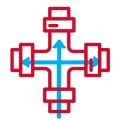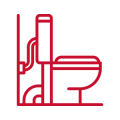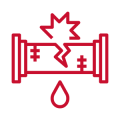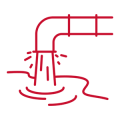What is Backflow?
What is the Definition of Backflow?
It essentially means the flowing back of water or reversal of the normal direction of water flow in either the Water System or a Customer’s Plumbing system into the public domain or water source
What Actually Happens?
Water flows from the public line into your home everyday. The average person in Calgary consumes 7,000 litres of water per day. Depending on the devices and water needs your home might need contaminated water may find itself back into the water supply without you even noticing it!
STEP 1

Clean water from the city flows in the home or business
STEP 2

Weter is used and the used water flows into the sewer
STEP 3

Sudden changes in pressure can reverse the flow
STEP 4

Polluted water backflows into water supply
Normal water use should go only one way. From the public supply line to the home or business and then to waste. Water Backflow devices are there to prevent that any sudden changes in pressure or water use alter the flow of the water in the opposite direction. This so-called ‘backflow’ can be triggered with a simple break in the main water line. When pressure is lost during these events, water is no longer being pushed forward into your home and will flow backward into the city of Calgary water supply. Backflow can pollute the public drinking supply with a variety of different contaminants used in the average house or business.
Cross Connection Control
backflow prevention device
A backflow prevention device is used to protect potable water supplies from contamination or pollution due to backflow.
In water distribution systems, water is normally maintained at a significant pressure to enable water to flow from the tap, shower, or other fixture.
Water pressure may fail or be reduced when a water main bursts, pipes freeze, or there is unexpectedly high demand on the water system. Reduced pressure in the pipe may allow contaminated water from the soil, from storage, or from other sources to be drawn up into the system.

IT IS THE LAW
IT KEEPS OUR DRINKING WATER SAFE
Calgary’s drinking water supply is safe and clean. Water backflow device valves ( cross connection ) prevent contaminated water to go backward essentially preventing contamination of our drinking water and that is why this test is so important.
CERTIFIED TESTING PRECEDURE
If you received a letter, you need to have your cross connection device tested by a certified tester who is registered with the City of Calgary. In order to pass the test, it must meet the following criteria:
- The Device Must Be appropriate to the Static Pressure of the line it is installed on
- The First Shut Off Must Close
- Check Valve 1 must close tight in the direction of flow
- Check Valve 2 must close tight in the direction of flow
- The second Shut Off Must close
In addition, the device must also be installed as per AWWA recommendations. AWWA stands for the American Water Works Association which is recognized as North America’s most prominent water inspection association.
An improperly installed device can result in the immediate failure of a device both in terms of operation and testing.

TESTING STAGES
It is important to understand what to expect during testing. A series of 3 tests are administered by the certified technician:
The first test will determine the Static Pressure on the line that the device is installed on. Each Double Check Valve Assembly is rated for a certain pressure range, so we want to verify that the correct device is installed for that pressure range. The technician will use a pressure gauge to determine this reading.
The second test will determine if the First Shut off to the device can fully close off flow through the device and will also determine whether Check Valve 1 can close tight in the direction of flow. By using either Site Tubes or a Differential Pressure Gauge, the technician will simulate 1PSI of pressure against Check Valve 1. Check Valve 1 must close tight against 1PSI of resistance for a minimum of 2 Minutes to pass this portion of the test.
The last test will determine if the Second Shut off is closed tight and determine whether the Second Check Valve can close tight in the direction of flow. Once again using either Site Tubes or a Differential Pressure Gauge the technician will simulate 1PSI of pressure against Check Valve 2. Check Valve 2 must close tight against 1PSI of resistance for a minimum of 2 Minutes to pass this portion of the test.
